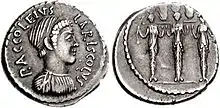Temple of Diana (Nemi)
The Temple of Diana Nemorensis was part of an ancient Italic monumental sanctuary erected around 300 BC and dedicated to the goddess Diana.[1] It was a popular place of worship until the late imperial age.
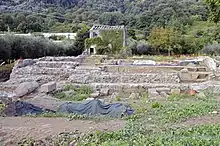 | |
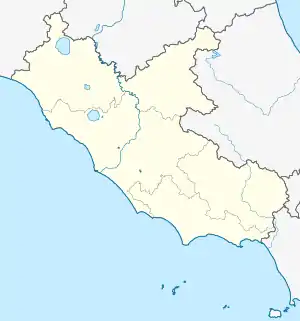 Shown within Lazio | |
| Location | Lazio, Italy |
|---|---|
| Region | Provincia di Roma |
| Coordinates | 41°43′28″N 12°42′33″E |
| Type | sanctuary |
| History | |
| Periods | Roman Republic Roman Empire |
| Site notes | |
| Excavation dates | yes |
| Public access | yes |
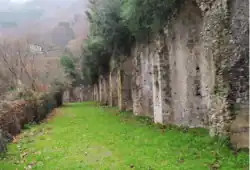
_01.JPG.webp)
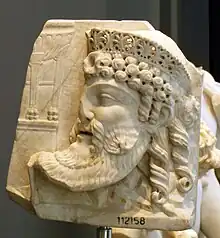
.jpg.webp)
The temple was situated on the northern shore of Lake Nemi, beneath the rim of the crater and the modern city of Nemi.[2]
History
Worship of Diana at Nemi may have flourished from at least the 6th century BC.[3]
The sanctuary was held by the Latin cities in common (the Latin League) and presided over by the Rex Nemorensis.[4] It was in the territory of the nearby town of Aricia which led to the town's development as an influential and affluent centre of healing and medicine.
The temple of Diana Nemorensis was preceded by the sacred grove of Aricia[5] in which there stood a carved cult image which survived until as late as 43 BC when it was reflected in coinage.[6] The Italic type of the triform cult image of Diana Nemorensis was shown in a sequence of later Republican period coins connected with a gens from Aricia.[7]
A three-day festival to Diana, the Nemoralia, was held yearly on the Ides of August from at least the 6th century BC, coinciding with the traditional founding date.[8] Records from the 1st century BC describe worshippers traveling to the sanctuary carrying torches and garlands.[9] Diana's festival eventually became widely celebrated throughout Italy, including at the Temple of Diana on the Aventine Hill in Rome.
The temple was built in about 300 BC and was noted by Vitruvius as being archaic and "Etruscan" in its form.[10] It continued in use until the late Roman Empire period when it was abandoned with the imposition of Christianity. Portions of its marbles and decorations were removed and the area of the temple was gradually covered by forest and generally left undisturbed for centuries.
Amateur, often foreign, archaeological excavations of the site began in the 1600s.[11][12] As a result, statues of splendid workmanship are now found scattered in many museums such as the University of Pennsylvania,[13] the Museum of Fine Arts (Boston) or in European museums such as the Nottingham Castle museum and the Ny Carlsberg Glyptotek.
A number of diminutive bronze statues of draped women and men, each holding libation bowls and incense boxes were found here, four of which are now in the British Museum's collection.[14]
Description
The sanctuary was built on a terrace of perimeter 200 x 175 m which was supported downhill by triangular substructures while uphill was a massive wall with semicircular niches which supported an upper terrace and in which were probably statues.[16] On the terrace ran two porticoes of the Doric order, one with red plastered columns, the other with dark gray peperino columns. The sanctuary included baths, theatre and a nymphaeum. There were also rooms for priests, lodgings for pilgrims and donation cells.
References
- Ghini, Giuseppina (1992). Il Museo delle navi romane e Il Santuario di Diana di Nemi. Roma: Ist. Poligrafico dello Stato. ISBN 978-8824002462.
- Quilici, L., S. Quilici Gigli (6 April 2021). "Places: 422917 (Diana, T.)". Pleiades. Retrieved April 6, 2021.
{{cite web}}: CS1 maint: multiple names: authors list (link) - Gordon, A.E. (1932). "On the Origin of Diana", Transactions and Proceedings of the American Philological Association 63 (1932, pp. 177-192) p 178.
- Publius Ovidius Naso, Fasti, Book 3, 271 (on the month of March)
- Strabo 5.3.12
- Alföldi, "Diana Nemorensis", American Journal of Archaeology (1960:137-44) p 141.
- Alföldi 1960:137-44. A small marble head from Nemi in the Museo delle Terme was an archaising replica of the form the goddess took at Nemi, in American Journal of Archaeology 1961:55f; see also P.J. Riis, "The cult image of Diana Nemorensis" Acta Archaeologica 37 (Copenhagen) 1966:37-65. Further examples of these denarii are at Coinarchives.com.
- Gordon, A.E. (1932). "On the Origin of Diana", Transactions and Proceedings of the American Philological Association 63 (1932, pp. 177-192) p 178
- Ovid, Fasti, trans. James George Frazer, Loeb Classical Library (Cambridge, MA: Harvard University Press, 1931), 3:259-275
- Vitruvius, 4.8.4.
- Maria Grazia Picozzi (2003). Jane Fejfer; Tobias Fischer-Hansen; Annette Rathje (eds.). "Orfeo Boselli and the Interpretation of the Antique". The Rediscovery of Antiquity: The Role of the Artist. Museum Tusculanum Press: 103–104. ISBN 9788772898292.
A letter by Giovanni Argoli dated in 1637, referred to in De donariis ac tabellis votivis by Jacopo Filippo Tomasini, informs us that (perhaps in the same year) the Frangipane, owners of the Rocca of Nemi and the land below, had carried out excavations which had brought to light many votive terracottas as well as a fragmentary statue, understood to be that of Diana herself: «simulacrum numinis ipsum, venatorio habitu succintum, mutilum tamen, mancumque; quid deterius est, capite ancisum» (Tomasini 1654, 13).
- Luigi Devoti (1987). Campagna romana viva (in Italian). Vol. 4. Associazione tuscolana Amici di Frascati. p. 90.
Le prime ricerche effettuate con carattere di ufficialità, se così possiamo dire, risalgono alla seconda metà del secolo XVII per opera dei Marchesi Mario e Pompeo Frangipani Signori di Nemi. Le notizie relative ci sono pervenute per una lettera inviata da Giovanni Argolo segretario del Cardinale Lelio Biscia al Tomassini e inserita nel suo scritto «DE DONARIIS VETERUM.»
- Sculpture from the Sanctuary of Diana Nemorensis at Lake Nemi. In: Irene Bald Romano (ed.): Classical sculpture: catalogue of the Cypriot, Greek, and Roman stone sculpture in the University of Pennsylvania Museum of Archaeology and Anthropology. University of Pennsylvania 2006, pp. 73–159.
- British Museum Collection
- (CNG)
- Filippo Coarelli, Laterza archaeological guides - Surroundings of Rome , I, Rome - Bari , Giuseppe Laterza & sons publishing house , 1981. pp. 100-103
Bibliography
- Giovanni Argoli, Epistola ad Jacobum Philippum Tomasinum de templo Dianae Nemorensis, in: Jacopo Filippo Tomasini, De donariis ac tabellis votivis liber singularis, Padova, 1654 in-4 pp. 13 ff.; reprinted in: Johann Georg Graevius, ed. (1699). Thesaurus antiquitatum romanarum. Vol. XII. pp. 751 ff.
- G. Ghini, Il Museo delle navi romane e Il Santuario di Diana di Nemi, Roma 1992.
- G. Ghini, F. Diosono, Il Santuario di Diana a Nemi: recenti acquisizioni dai nuovi scavi, in E. Marroni (ed.), Sacra Nominis Latini. I santuari del Lazio arcaico e repubblicano. Atti del Convegno, Roma 2009, Ostraka n.s. 2012, I, pp. 119–137.
- F. Coarelli, G. Ghini, F. Diosono, P. Braconi Il Santuario di Diana a Nemi. Le terrazze e il ninfeo. Scavi 1989-2009, Roma, L'Erma di Bretschneider, 2014, ISBN 978-88-913-0491-9.
- Sculpture from the Sanctuary of Diana Nemorensis at Lake Nemi. In: Irene Bald Romano (ed.): Classical sculpture: catalogue of the Cypriot, Greek, and Roman stone sculpture in the University of Pennsylvania Museum of Archaeology and Anthropology. University of Pennsylvania 2006, pp. 73–159.
- Giulia D'Angelo - Alberto Martín Esquivel, P. Accoleius - Lariscolus (RRC 486/1) in Annali dell'Istituto Italiano di Numismatica, 58 (2012), pp. 139–160.
